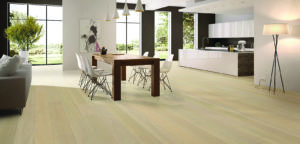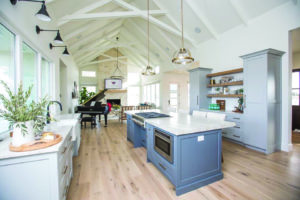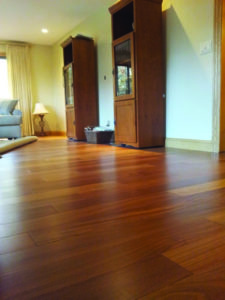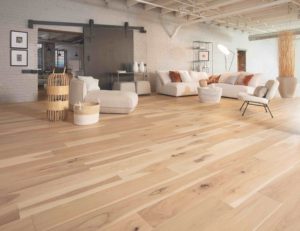Following is the third edition of the Real Wood Coalition editorial coverage, which can also be seen in the March 15/22 print edition of FCNews.
These features include educational insights, new and staple hardwood products and a spotlight featuring one of the Coalition’s members. A new edition of RWC coverage will be available in every print issue of FCNews throughout the year.
DID YOU KNOW
Utilizing hardness as a determining factor in species selection for residential applications

When most consumers assign attributes to hardwood flooring, they typically cite the product’s natural aesthetic appeal as well as the value it adds to the home. But what about the product’s natural ability to stand up to wear and tear? Playing up hardwood’s inherent strength—particularly in comparison to competing categories that also tout proven durability—can go a long way in giving RSAs more ammunition to persuade consumers to choose real hardwood over other options.
The first step is to explain to the customer the differences between the major species. Each wood species or sub-species has an inherent hardness dictated by its cellular composition. Wood species hardness determination follows a very precise method used to rank both hardwoods and softwoods on a comparable scale, from harder to softer. The method was created in 1906 by Gabriel Janka, an Austrian-born wood researcher, and in 1972 standardized by the American Society for Testing and Materials (ASTM). Now known as the Janka Scale, it quantifies the resistance of a wood species (in pound-force lbf) to denting by measuring the force required to embed a 0.444 steel ball to half its diameter into a plank.
Generally speaking, hardwood starts at a rating of 950, a rating that is suitable for most standard residential requirements. Common species that offer high dent resistance but still provide relative ease of milling and handling include hard maple (a.k.a Canadian Maple), white oak, ash, beech and red oak. Many imported species—particularly those from South America—boast even higher Janka ratings. Brazilian ebony, Brazilian walnut and Bolivian cherry, for example, have Janka ratings exceeding 3650 cycles on the Janka scale. Another favorite, Brazilian cherry (Tauri) has a rating of 2350. “Tauri is harder than white oak and red oak,” said Jodie Doyle, vice president of U.S. sales and marketing, Indusparquet.
Whether it’s a popular domestic species or an imported product with a funny name, the key to educating the customer is simple: When communicating technical information such as this, first determine how much foot traffic the consumer expects to generate in her home—including that of pets and children—and recommend the appropriate species.
SELLING TIPS
ABCs of specifying wood floors
 There are several key factors RSAs should consider when recommending a particular hardwood flooring style or type. While the consumer may initially base her decision on color, width or grain pattern, there are other questions that need to be answered before specifying the right product for her needs.
There are several key factors RSAs should consider when recommending a particular hardwood flooring style or type. While the consumer may initially base her decision on color, width or grain pattern, there are other questions that need to be answered before specifying the right product for her needs.
For example, where will the new floor be installed—on, above or below grade? This will eliminate some options right off the bat. “Engineered wood flooring is ideal for basements, while both solid and engineered wood floors may be installed in any room that is on or above ground,” said Brett Miller, vice president of technical standards, training and certification for the National Wood Flooring Association.
Solid wood flooring is made of one piece of wood from top to bottom, while engineered wood flooring is constructed using multiple layers, including a top layer of high-quality wood. This construction makes the floor less susceptible to expansion and contraction based on seasonal temperature fluctuations or humidity levels within the home.
Once the proper construction is chosen for a particular application, the RSA can help the consumer decide on a particular style. Options include: strip, plank, parquet or end grain. “Strip flooring is usually less than 3 inches wide and often makes a room appear larger,” Miller explained. “Plank flooring is 3 inches or wider and often creates a more casual look. Parquet varies in size and generates a geometric, non-linear look.”
Color tone also factors in heavily during the selection process. Most factory-milled and finished floors come with the stain already applied, but some customers may opt for unfinished flooring, which can then be colored on site. “Finish tones the natural color of the wood up or down, making lighter or darker versions of the wood,” Miller explained. “Typically, light tones make a room look more open and airy, while medium tones make the room feel warm and cozy. Dark tones can make a room appear stately and refined.”
Last, but certainly not least, is the choice of gloss level. “Trend surveys indicate low-gloss finishes remain in high demand,” Miller said. “However, if the consumer changes her mind down the road, it’s easy to transform the look.”
TRIED AND TRUE
Nature Flooring’s Brazilian Teak
Nature Flooring, a renowned supplier of imported woods with manufacturing operations in Peru and Poland, continues to report strong sales of its solid Brazilian teak flooring. Exotic and beautiful, the products in the line feature a unique grain pattern, natural color and smooth surface. Brazilian teak has a hardness rating of 3540 on the Janka scale, making it one of the most durable species available. It is 5 inches wide and features seven coats of aluminum oxide.
NEW AND NOTABLE
Hickory Sandy Reef Character from Mirage
Brushed Sandy Reef, part of the Flair Collection, reveals the pure and natural beauty of hickory like no other color. It is an off-white shade that subtly allows the natural color of the wood species to show through, while the DuraMatt finish provides a matte, high-end look.
Mercier—40 years of innovation
It has been 40 years since Mercier Wood Flooring first made its lasting imprint on the hardwood flooring industry. Mercier is the culmination of what happens when you combine an innovative mindset and a love of both authenticity and wood. For decades, the company has developed an expertise in subtly mastering the complexity of wood surfaces. In recognition of its 40th anniversary, Mercier is reaffirming its roots and culture of innovation with a brand-new tag line: “The Original Prefinished Wood Flooring.” Much more than just a slogan, the statement connects Mercier Wood Flooring’s long heritage and bright future. It also focuses on the mastery of a hardwood floor’s surface—which has been at the heart of the Mercier brand for generations.
Proudly designed and manufactured in Canada, Mercier Solid and Engineered wood floors have always been steps ahead in terms of the company’s technological innovations as well as its designs. While its wood flooring collections are profoundly aligned with the latest in interior decorating, they are nevertheless infused with a classic style to remain striking day after day, year after year. Thanks to Mercier’s high-performance finishes, the beauty of its genuine hardwood flooring products can be admired in both residential and commercial applications where they will continue to make people proud of their living and working spaces for a long time.

